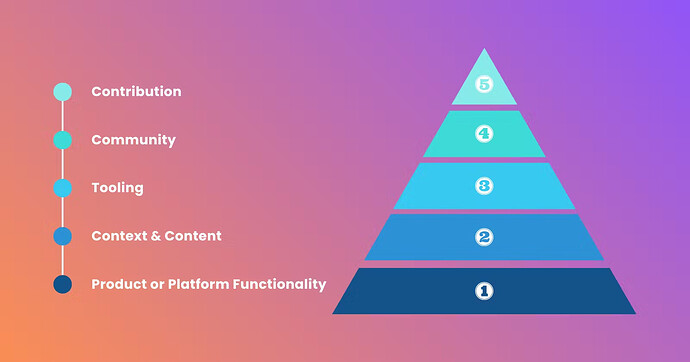When establishing a developer relations program, it’s essential to understand what developers prioritize. Drawing inspiration from Maslow’s hierarchy of needs, I formulated the “developer’s hierarchy of needs.” This model presents a clear structure to understand how different requirements are layered, with the foundational ones serving as prerequisites for the subsequent levels.
This became a mental/visual overlay that I would apply over the current state of the business I was in to determine the health at each level. Each quarter, I would focus on initiatives that were the most unhealthy, starting from the lowest levels of the hierarchy and working my way up.
The Model
Much like Maslow’s hierarchy starts with physiological needs, developers’ essentials begin from the base and work upwards—here’s how it works.
Product and Platform
At the core, developers demand a dependable product complete with robust APIs, webhooks, and other essential features. Before documentation, tools, or community can have any effect, your product and platform must work, and work well.
In my current role, we recognized the need to bolster our API credibility, which led to:
- Forming an API guild with Engineering
- Mandating API guidelines
- Incorporating an API linter and schema validator into our API release process
- Joining product roadmap & planning sessions, and engineering architecture calls regularly
This reinforced commitment paved our way for the next tier.
Context and Content
For developers, comprehensive documentation, API specifications, and guides are crucial. Our DevRel team executed hundreds of requests and committed countless enhancements internally to our API specs to get them into shape. We also authored guides and best practices, offering developers context beyond just the technical inputs and outputs. This intensive focus spanned two quarters, later evolving into a regular facet of our program. Our recent ventures also encompass video and blog content from time to time.
Tooling
Optimal tooling, like SDKs and CLIs, fosters ease of integration. However, their efficacy hinges on robust documentation and API specifications. With our improved APIs and accompanying guidance, we prioritized tools to expedite developers’ tasks beyond just the docs. We rolled out open-source, MIT-licensed offerings such as:
- SDKs
- CLI
- Company-curated Postman collection
- Example applications
- …and more
Community
A healthy, active developer community is an incredible tool for learning, networking, and recognition. Building upon our becoming-reliable product offerings and tooling, we aimed to cultivate an engaged user community around scalable identity governance solutions. Our community-focused initiatives included:
- Introducing a core community forum
- Hosting our inaugural virtual, developer conference in 2023
- Kickstarting an ambassador program for technical contributors
- Exploring future meetup opportunities
Contribution
At the pinnacle, akin to Maslow’s self-actualization, developers yearn to reciprocate, be it through enhancing the product or leading the community. This engagement not only satisfies their creative instincts but also cements their loyalty to your product. Presently, our community focuses on active contributors, with efforts to further this engagement, including a forthcoming marketplace aimed at incentivizing customer and partner contributions.
Closing
This hierarchy has provided me with a strategic lens to explain our team’s focus at any given point. If you’re discerning your developer relations team’s direction, benchmark your product against this hierarchy to pinpoint areas of enhancement. Start where the gap is the widest.
